When all has been said and done, our side did pretty well for only having a few hours to put a counter-protest together. I counted 42 people in our group, and 25 people in theirs. Except they had their act together a bit more. They marched in from the center of Langhorne Borough, to Frank Farry’s office, while our group was already gathered outside the building. The CeaseFirePA folks immediately monopolized the area in front of traffic, which was smart on their part. Our group mistakenly went to join them, which only served to make their group look bigger than it really was, and given that many people on out side did not have signs, that wasn’t going to be a winning tactic.
Eventually our side kind of figured things out and spread out along the street to make our point to passing traffic. The good thing there is when people drive by and honk, you can’t be sure who they are supporting. This denied the other side the emotional self-satification of thinking everyone supports them.
Because there was only a few hours notice, few in our group had signs, whereas almost all the CeaseFire people had signs, and they also had a large banner. They had more time to plan. One thing it taught us to have signs on hand and ready to go at a moments notice. Folks honored the request not to open carry long guns, and both our people and their people were sending people inside the office to make ourselves heard.
One thing I’d note is that a lot of people want to argue with the other side. I tend to think this is rather pointless. The folks that show up to these rallies are going to be true believers, and not amenable to having their minds changed. All it accomplishes is making their group look bigger. I’m a big fan of staying in two different areas. Our group was bigger, and that could have been very apparent to any person driving past, or to any reporters covering the events.
The purpose of counter-protest is a) denying your opponents the emotional satisfaction of believing they own the field, and b) making sure the media covers both sides of the issue, and c) demonstrating organizational effectiveness to the particular lawmaker targeted. I believe we accomplished a) and c) pretty well, and probably b) too, but we’ll have to see how the media spins it. If they end up misreporting the numbers, that’s because it was really hard to tell once this got going. I counted out our folks before they arrived, and counted their folks as they marched in.

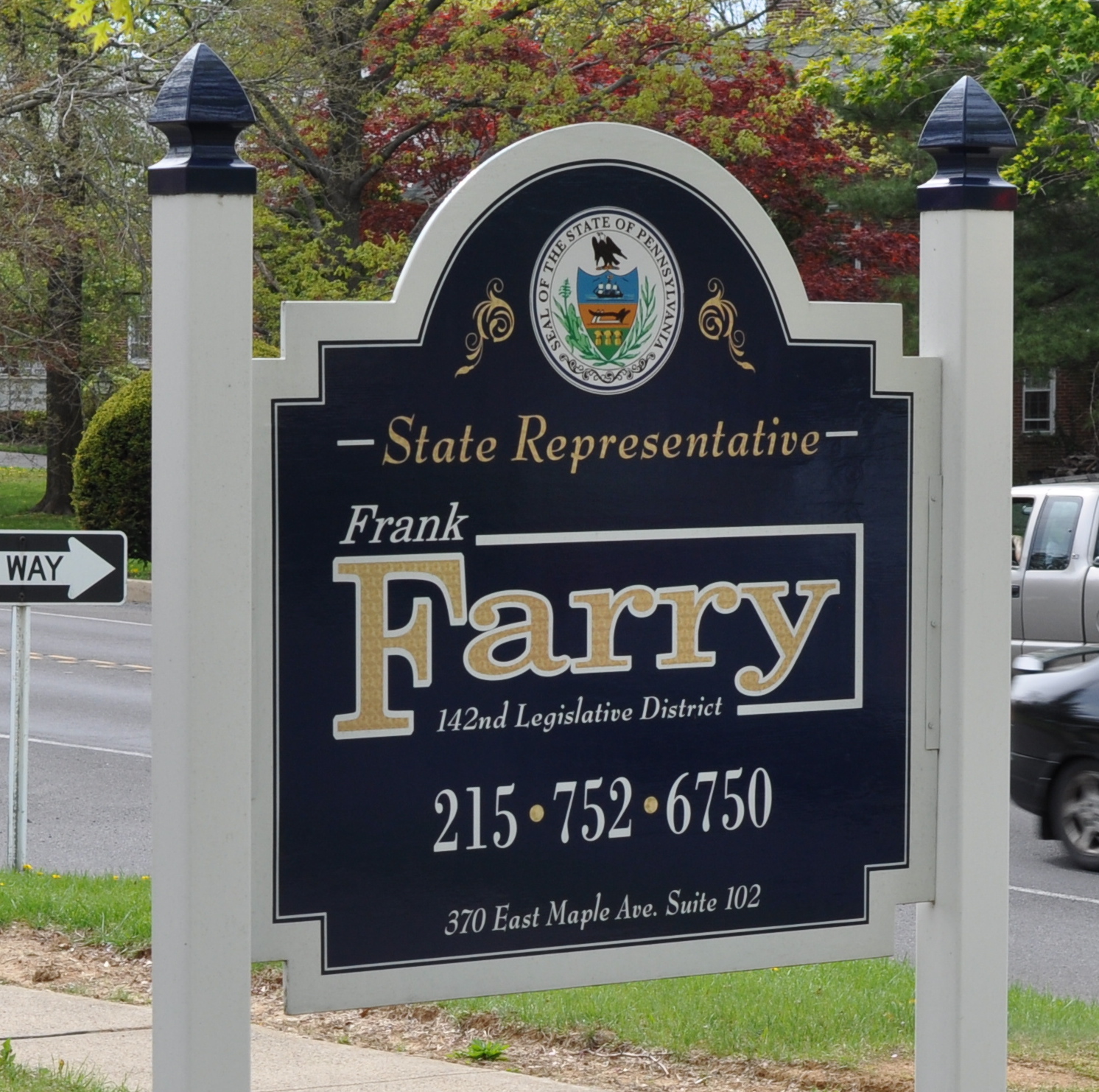

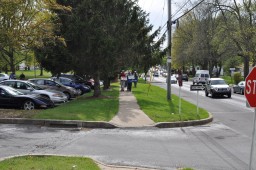
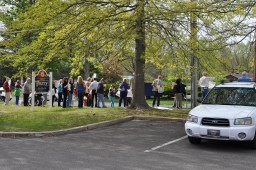
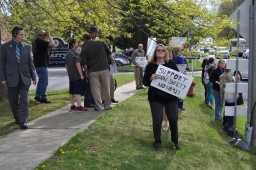
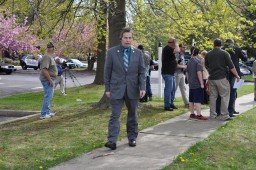
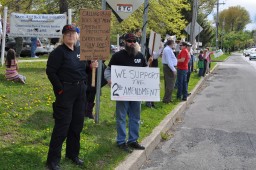
They’ll believe it anyway.
And looking down at the pictures, I wouldn’t worry if people can remember bill numbers. It’s a moot point if the number is illegible. = )
It won’t affect all of them, but it’ll affect some of them.
Does this deserve any attention at all?
Yes, because I want to show the particular lawmaker that we can organize locally, even on a moment’s notice.
Sorry. I did not realize this was local to you and you were involved. Good job.
Though, does it deserve attention on the blog? That’s another question :) But I was there, taking pictures, so I post it.
Oh it definitely does. We need to know how to protest appropriately, and how the other side does it so we can counter properly.
It would probably be worthwhile to put together a compilation of tactics (e.g., “don’t make the enemy look bigger”) and copy them into all alerts sent out, etc. Encourage people to self-drill on them, to be prepared for instant responses.
Inside, talking to Farry’s aid in the office, she seemed aware that we had outnumbered them and that our side’s efforts were “spontaneous” as opposed to the opposition’s carefully coordinated effort. I think those things are important for leading the legislators to the conclusion that we are more self-motivated than they are — which will be evidenced in the voting booth.
It would be a good thing to do, I agree. But I’ll admit I wouldn’t have thought of some of these issues ahead of time until I saw what the other side was doing. I knew going in we should probably have signs, but we could print 8.5×11 on short notice. We didn’t have markers or larger poster paper on hand. We’ll have to remedy that for the future.
I’d also admit I’m not a natural protestor, and I’m a far better observer and commenter than leader. So it’s easy for me to analyze things and say where we’re going wrong. It’s harder for me to anticipate and take charge. I’m generally more inclined to say “this isn’t my protest,” and sit back and wait for someone to do something than trying to take matters into my own hand. I’ve found that successful activists often don’t have regard for those kinds of boundaries, but that’s generally not me. I’m probably too reluctant in many situations to step on other people’s toes, even when there might not be other toes to step on.
I don’t want to pretend I have a lot of experience with these “counter-rally” kinds of things, which have seemed to evolve only in recent years. My fondest memory of a counter-rally was way back in October 2000, when about 2500 of us turned out to counter a march by what turned out to be about 75 of the “Million Moms” across the Fahy Bridge in Allentown/Bethlehem. But, we had weeks to work on planning and recruitment, which is why we achieved a massive turnout. It also was preceded by a good deal of infighting regarding tactics, with opinions ranging from, no confrontation at all (just a parallel rally of our own) to opinions favoring violent confrontation — throwing water balloons, vegetables, and other missiles. As it turned out we lined the bridge walkway and turned our backs to the Moms as they marched past — then held a rally of our own. But the point is, there were weeks of planning behind a coordinated effort, and oddly, it seemed a huge crowd was more inclined to follow guidelines than small crowds tend to be.
I think for now the spirit should be, it is never too late to start learning from experience. Jotting down notes of some of the top-level, obvious things is a good first step toward developing basic tactics, and being able to justify those tactics is important to having them adhered to by participants.
Great write up, especially for the lessons learned. Don’t crowd them, don’t try to convince them, don’t appear intimidating. Do bring women and children, do bring signs that are clear, polite and/or funny, do follow rules and have fun.
One of the things I learned from the Walter Steed incident is to have markers and some poster board handy in my rigs if not at least sitting in the garage.
Other lessons is to have resources available for multiple different tactics. In that particular incident and what it centered around I really should have brought my AR to OC. (It was also about 20 degrees so was probably the easiest to OC). I left it at home because I didn’t want to be the only one. Ended up there was a number who did bring their rifles and I should have at least had it with me instead of a half hour away.
Be ready to pivot and change tactics. I learned at the I-594 hearings the opposition is more than happy to cheat to get in to the hearing so you’re locked out. Well, luckily I knew people so !@#$ that crap. In the door I went at the front of the line.
Engaging and not engaging depends entirely on the circumstances. If they want to engage, do so. Do not cede that field to them since you can quite easily own it. Take the win.
Lastly first guy who shows up should take control unless someone with more experience shows up. Think of it like the incident commander at a fire or accident scene. Someone needs to manage the situation to try and prevent many of the issues you ran into. As the group size grows, delegate people different roles and management of sections of the crowd. The key here is we have to be able to go effectively on short notice.
There has been talk in my neck of the woods to organize an educational seminar on effective politieering. From Protests, to public speaking, proper public engagement, and even working with legislators.
Me thinks I need to chat with someone on that again.
I think that kind of seminar is a good idea. It’s tough seeing mistakes being made but not feeling like you have the standing to tell people what to do. Plus, a lot of our people take grave exception to feeling like they are being herded.
Wonderful blog! I found it while surfing around on Yahoo News. Do you have any tips on how to get listed in Yahoo News? I’ve been trying for a while but I never seem to get there! Appreciate it kdeefdeeceeb